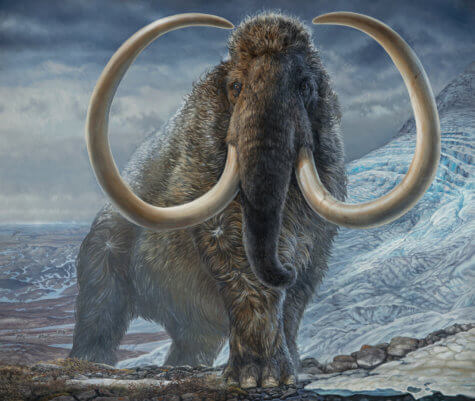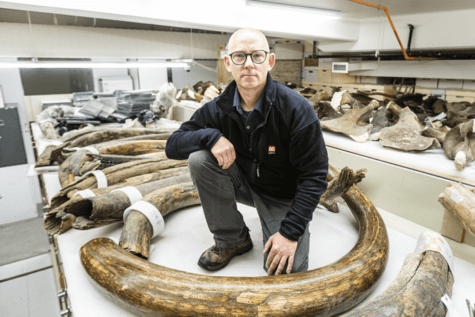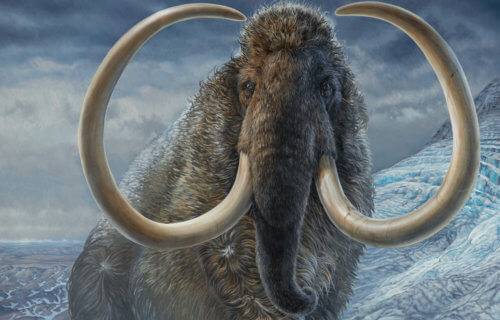FAIRBANKS, Alaska — A woolly mammoth’s astonishing life has been retraced by scanning its six-foot tusk. According to the study, by the time of death at the age of 28, it had covered enough of the Alaskan landscape to almost circle the Earth — twice. Due to being kicked out of its herd, the male roamed so far until It finally succumbed to starvation.
The findings are based on a chemical analysis of its 17,000-year-old fossilized woolly mammoth tusk housed in the University of Alaska Museum of the North. “From the moment they are born until the day they die, they have a diary – and it is written in their tusks. Mother Nature doesn’t usually offer up such convenient and life-long records of an individual’s life,” says Pat Druckenmiller, a paleontologist and director of the University of Alaska Museum of the North, in a statement.

It sheds fresh light on the iconic Ice Age beast’s behavior and movements – revealing for the first time the vast distances they traveled. The study also has implications for saving animals from extinction today.
“It is not clear if it was a seasonal migrator – but it covered some serious ground. It visited many parts of Alaska at some point during its lifetime, which is pretty amazing when you think about how big that area is,” explains co-lead author Professor Matthew Wooller, of the University of Alaska Fairbanks.
Isotopic data enabled the international team to match the woolly mammoth’s whereabouts and diet with maps of the region. They split the tusk lengthwise and generated about 400,000 microscopic data points using a laser and other techniques. It was made possible because of the unique way they grew, with new layers added steadily on a daily basis.
The growth bands were described as looking “like stacked ice cream cones,” offering a chronological record of the mammoth’s entire life. It perished on Alaska’s North Slope above the Arctic Circle where its remains were unearthed. The researchers pieced together the mammoth’s journey up to that point from the elements strontium and oxygen.
They linked them to charts that predicted isotope variations across Alaska. The maps were created by scanning the teeth of hundreds of small rodents held in the museum’s collections, since they travel relatively small distances during their lifetimes. This opened a window into isotope signals.

Using the local dataset provided a baseline to track the woolly mammoth’s steps. Geographic barriers and weekly average distances were taken into account. Spatial modeling was used to draw up its likely routes.
What scientists learned about this woolly mammoth
From ancient DNA preserved in its bones, it was identified as a male, found to be related to the last group that lived on the mainland. An abrupt shift was discovered in its isotopic signature, ecology, and movement at about the age of 15. This probably coincided with the mammoth being banished from its herd, mirroring a pattern seen in modern-day male elephants.
“Knowing he was male provided a better biological context in which we could interpret the isotopic data,” says co-author Professor Beth Shapiro, of the University of California Santa Cruz. They also offered a clue about what led to its demise. Nitrogen isotopes spiked during the final winter of its life, a sign of starvation in mammals.
“It is just amazing what we were able to see and do with this data,” adds co-author Professor Clement Bataille, of the University of Ottawa. Woolly mammoths died off after the weather became warmer and their food supply changed. They were also hunted by humans.
As an adaptation to the cold, woolly mammoth ears were much smaller which kept them closer to their heads. Their tusks could reach up to 15 feet and were used for fighting and digging in the deep snow. Mammoths were gentle giants and ate mostly grass and other types of plants and flowers.

Discovering more about the lives of extinct species satisfies more than curiosity. Those details could be surprisingly relevant now as animals adapt their movement patterns and ranges with the shifting climate.
“The Arctic is seeing a lot of changes now, and we can use the past to see how the future may play out for species today and in the future. Trying to solve this detective story is an example of how our planet and ecosystems react in the face of environmental change,” said Professor Wooller.
This study is published in Science.
South West News Service writer Mark Waghorn contributed to this report.
